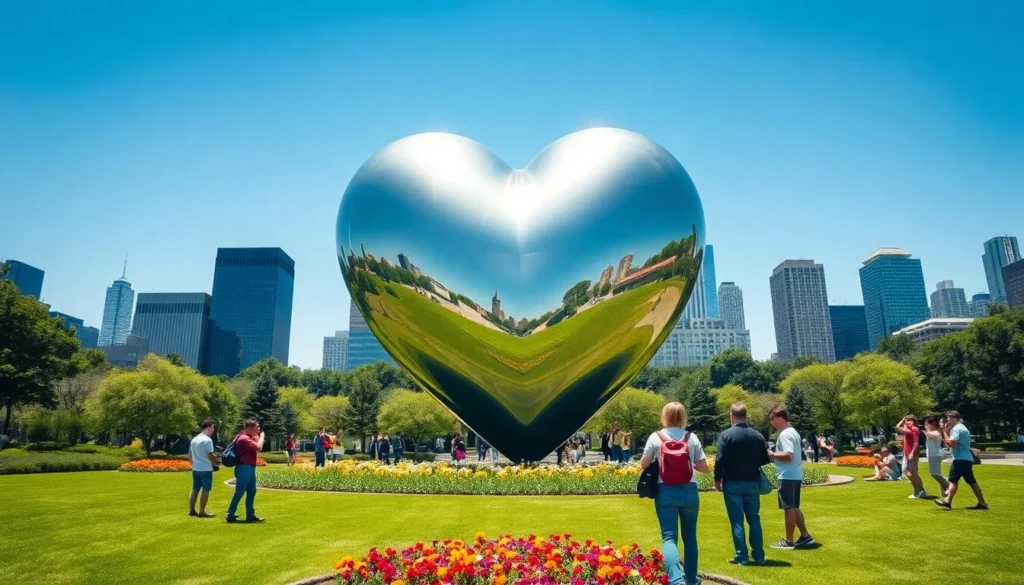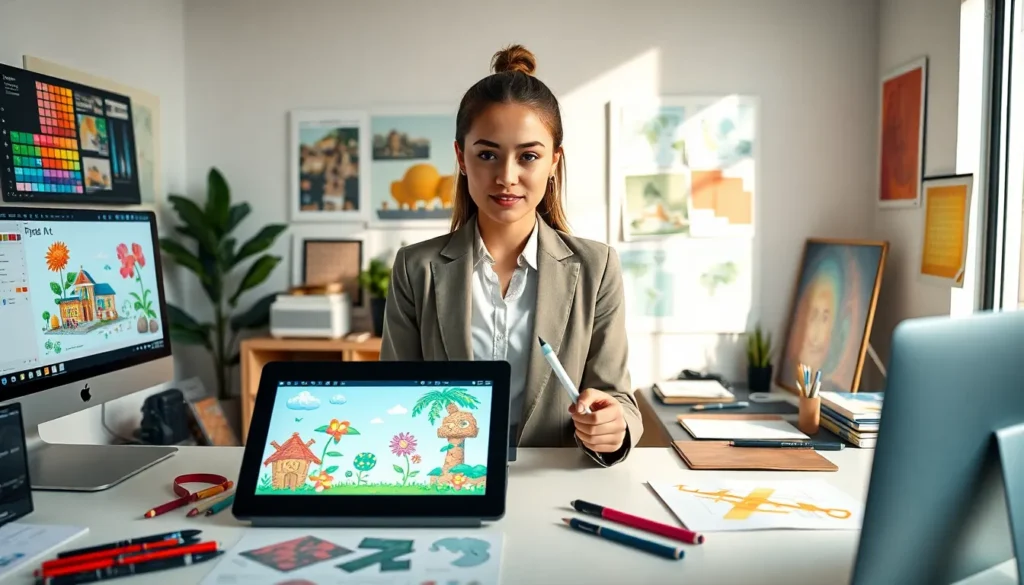Table of Contents
TogglePublic sculpture transforms ordinary spaces into extraordinary experiences. Imagine strolling through a park and suddenly encountering a giant rubber duck or a towering abstract figure that makes you question your understanding of art. These whimsical creations not only beautify urban landscapes but also spark conversations and ignite imaginations.
From the iconic “Charging Bull” on Wall Street to the playful “Angel of the North” in England, public sculptures have a knack for making statements. They invite everyone to pause, reflect, and sometimes chuckle at the absurdity of life. As cities embrace these artistic wonders, they create a unique blend of culture and community that enriches everyday life. So, next time you spot a quirky piece of public art, take a moment to appreciate the creativity that’s literally standing right in front of you.
Overview Of Public Sculpture
Public sculpture encompasses large-scale artworks displayed in outdoor environments, often found in urban settings. Sculptors frequently create these pieces to engage the public and evoke emotions. Statues and installations serve as focal points in parks, squares, and plazas, enhancing the aesthetic value of the surrounding area.
Sculptures such as the “Charging Bull” in New York City symbolize financial strength and resilience. Similarly, the “Angel of the North” in Gateshead, UK, represents hope and inspiration. Each installation contributes unique narratives to its environment, inviting viewers to explore various themes and ideas.
Public sculptures play a vital role in community engagement by acting as conversation starters. Local artists often reflect cultural identity through their work, fostering a sense of pride. In many cases, communities participate in the commissioning process, ensuring the artwork resonates with local values and history.
Maintenance of public sculptures is essential for preserving their artistic integrity. Cities frequently establish committees responsible for the care and restoration of these artworks. Regular assessments help address wear and environmental damage, allowing these pieces to endure for future generations.
Funding for public sculpture projects typically comes from various sources. Government grants, private donations, and fundraising events contribute to the realization of these installations. Each funding avenue helps sustain the growth of public art and supports the continued evolution of urban spaces.
Understanding the significance of public sculpture encourages appreciation and respect for artistic contributions in everyday life. Engaging with these works cultivates a deeper connection between individuals and their communities, enriching the overall cultural landscape.
Historical Context
Public sculpture has deep roots in human history, showcasing cultural values and communal beliefs. The evolution of this art form mirrors the development of societies.
Ancient Civilizations
Ancient civilizations greatly valued public sculpture. Egyptians created massive statues for temples, while Greek sculptors designed lifelike figures that celebrated gods and heroes. Roman societies commissioned sculptures to commemorate victories and exemplify power. These artworks often adorned public spaces, reflecting communal identity and societal priorities. Distinguished sculptures served both religious and political functions, embedding themselves within the fabric of daily life.
Modern Movements
Modern movements in public sculpture emerged in the 19th and 20th centuries. The rise of public art initiatives encouraged artists to explore new themes and materials. Pop art, minimalism, and environmental art challenged traditional concepts, turning urban spaces into canvases. Iconic works, like Claes Oldenburg’s “Tweedy Bird,” exemplified the playful engagement between the viewer and the art. Contemporary public sculptures continue to inspire dialogue, addressing social issues and celebrating diversity within community contexts.
Types Of Public Sculpture
Public sculptures primarily fall into two categories: architectural integration and stand-alone installations. Each type serves a unique purpose and enhances urban landscapes in distinct ways.
Architectural Integration
Architectural integration refers to sculptures that complement or enhance existing structures. These artworks seamlessly blend with buildings and plazas, creating a cohesive visual experience. Notable examples include the intricate designs found in the facades of museums or public libraries, where sculptures serve as both aesthetic additions and functional elements. This type of sculpture not only adds beauty but also engages viewers by creating narratives that relate to the building’s purpose and history. Furthermore, architectural integration fosters a greater appreciation for the surrounding architecture, encouraging locals and visitors to connect with their urban environment.
Stand-Alone Installations
Stand-alone installations exist independently, making bold statements within their surroundings. These sculptures often occupy parks, squares, or other open spaces, drawing attention through their size or artistic uniqueness. For instance, works like “The Bean” in Chicago invite interaction and provoke thought among passersby. Such installations become conversation pieces, inviting viewers to engage with their themes and forms. They often symbolize community values or historical events, fostering civic pride. Stand-alone installations encourage exploration within urban settings, inviting an appreciation for public art in everyday life.
Impact Of Public Sculpture
Public sculpture significantly influences urban environments and communities, enhancing aesthetic appeal and fostering engagement. By acting as focal points, these pieces encourage interaction among residents and visitors.
Social Influence
Public sculptures enrich social experiences by promoting dialogue within communities. They invite individuals to share feelings and interpretations, fostering connections between people. Moreover, these artworks often reflect local culture and values, creating a sense of belonging. Events, like unveiling ceremonies, establish community bonds and encourage collective participation, which strengthens civic pride. Street performances near sculptures attract diverse groups, turning art into a communal experience. They also invite diverse interpretations, allowing people from various backgrounds to express their perspectives. Ultimately, public sculpture contributes to a vibrant social fabric, fostering inclusivity and engagement.
Economic Benefits
Public sculptures can drive economic growth by attracting tourism and revitalizing neighborhoods. Tourist visits to monumental works often increase foot traffic, benefiting local businesses. Increased foot traffic leads to sales boosts for shops and eateries nearby, contributing positively to the local economy. Additionally, municipalities recognize the value of integrating public art into urban design, often leading to higher property values. Dedicated public art programs enhance neighborhood appeal, making properties more desirable. Grants and funding aimed at public sculpture projects create jobs for artists and workers involved in installation and maintenance. These economic impacts stimulate growth, demonstrating the tangible benefits of investing in public sculpture.
Notable Examples
Public sculpture features numerous remarkable installations that resonate with viewers. Iconic works often serve as symbols of cultural significance, marking their locations as landmarks of community pride.
Iconic Sculptures Worldwide
Famous pieces include the “Statue of Liberty” in New York City, symbolizing freedom and democracy. Another notable work, “The Little Mermaid” in Copenhagen, celebrates Danish culture and literature. Sydney’s “Sydney Opera House” incorporates sculptural elements into its architectural design, showcasing artistic innovation. Paris hosts “The Thinker” by Rodin, reflecting deep philosophical inquiries. Each installation invites public interaction and cultural exchange, fostering diverse experiences for residents and tourists alike.
Local Favorites
Community favorites often showcase local heritage. Chicago’s “Cloud Gate,” affectionately called “The Bean,” attracts thousands with its reflective surface and engaging design. In San Francisco, “The Dancers” reflects the city’s vibrant artistic spirit. Philadelphia features the beloved “Rocky Steps,” where visitors recreate iconic moments from the film. These artworks resonate with residents, creating a distinctive connection to local history and identity, enhancing the sense of belonging within the urban landscape.
Conclusion
Public sculpture stands as a testament to the power of art in shaping urban landscapes and community identities. These installations invite individuals to engage with their surroundings in meaningful ways while fostering dialogue and connection among residents. Through their ability to reflect cultural values and provoke thought, public sculptures enrich the social fabric of cities.
As cities continue to evolve, the role of public sculpture becomes even more significant. By investing in these artistic expressions, communities not only enhance their aesthetic appeal but also cultivate a sense of pride and belonging among their residents. The ongoing support for public art projects ensures that these vital contributions to urban life remain accessible and impactful for generations to come.




